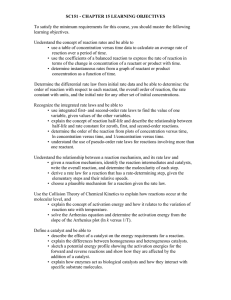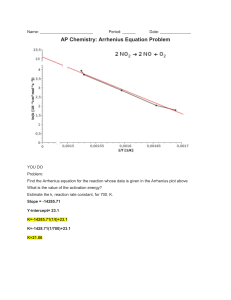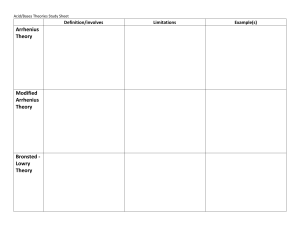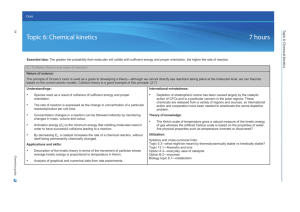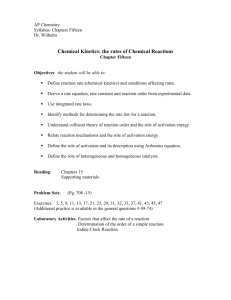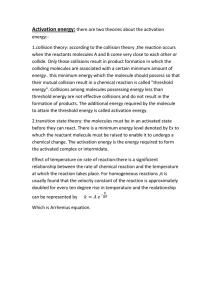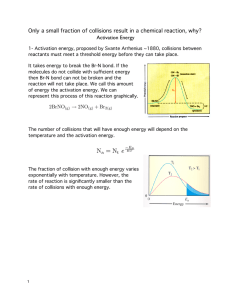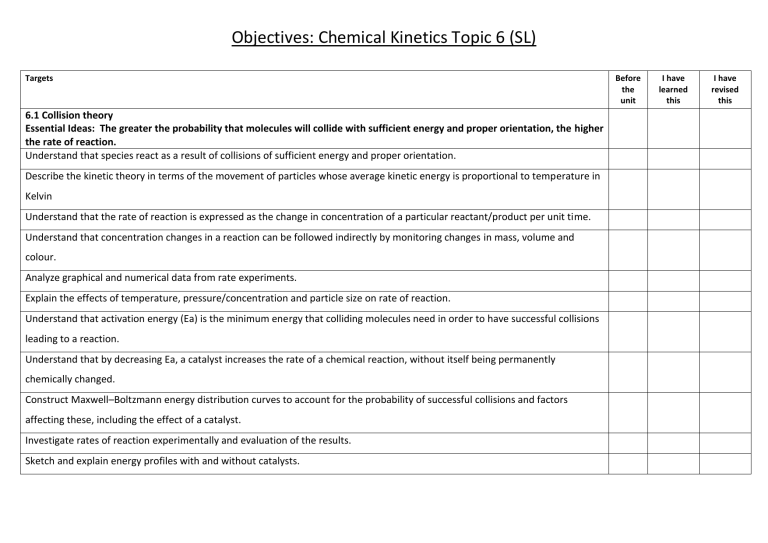
Objectives: Chemical Kinetics Topic 6 (SL) Targets 6.1 Collision theory Essential Ideas: The greater the probability that molecules will collide with sufficient energy and proper orientation, the higher the rate of reaction. Understand that species react as a result of collisions of sufficient energy and proper orientation. Describe the kinetic theory in terms of the movement of particles whose average kinetic energy is proportional to temperature in Kelvin Understand that the rate of reaction is expressed as the change in concentration of a particular reactant/product per unit time. Understand that concentration changes in a reaction can be followed indirectly by monitoring changes in mass, volume and colour. Analyze graphical and numerical data from rate experiments. Explain the effects of temperature, pressure/concentration and particle size on rate of reaction. Understand that activation energy (Ea) is the minimum energy that colliding molecules need in order to have successful collisions leading to a reaction. Understand that by decreasing Ea, a catalyst increases the rate of a chemical reaction, without itself being permanently chemically changed. Construct Maxwell–Boltzmann energy distribution curves to account for the probability of successful collisions and factors affecting these, including the effect of a catalyst. Investigate rates of reaction experimentally and evaluation of the results. Sketch and explain energy profiles with and without catalysts. Before the unit I have learned this I have revised this Objectives: Chemical Kinetics Topic 16 (HL) Targets 16.1 Rate expression and Reaction Mechanism Essential Idea: The concept of the energy change in a single step reaction being equivalent to the summation of smaller steps can be applied to changes involving ionic compounds. Understand that reactions may occur by more than one step and the slowest step determines the rate of reaction (rate determining step/RDS). Understand that the molecularity of an elementary step is the number of reactant particles taking part in that step. Understand that the order of a reaction can be either integer or fractional in nature. The order of a reaction can describe, with respect to a reactant, the number of particles taking part in the rate-determining step Understand that rate equations can only be determined experimentally. Understand that the value of the rate constant (k) is affected by temperature and its units are determined from the overall order of the reaction Deduce the rate expression for an equation from experimental data and solve problems involving the rate expression. Sketch, identify, and analyse graphical representations for zero, first and second order reactions. Evaluate proposed reaction mechanisms to be consistent with kinetic and stoichiometric data. Understand that catalysts alter a reaction mechanism, introducing a step with lower activation energy. 16.2 Activation Energy Essential Idea: The activation energy of a reaction can be determined from the effect of temperature on reaction rate. Nature of Science: Theories can be supported or falsified and replaced by new theories—changing the temperature of a reaction has a much greater effect on the rate of reaction than can be explained by its effect on collision rates. This resulted in the development of the Arrhenius equation which proposes a quantitative model to explain the effect of temperature change on reaction rate. Understand that the Arrhenius equation uses the temperature dependence of the rate constant to determine the activation energy. Understand that a graph of 1/T against ln k is a linear plot with gradient – Ea / R and intercept,lnA. Before the unit I have learned this I have revised this Understand that the frequency factor (or pre-exponential factor) (A) takes into account the frequency of collisions with proper orientations. Analyse graphical representation of the Arrhenius equation in its linear form ln 𝑘 = −𝐸𝑎/RT+ ln 𝐴. Use the Arrhenius equation 𝑘 = 𝐴𝑒−𝐸𝑎𝑅T . Describe the relationships between temperature and rate constant; frequency factor and complexity of molecules colliding. Determine and evaluate values of activation energy and frequency factors from data.

